Speech The Louisa Macdonald Oration

Alexandra Heath
Head of Economic Analysis Department
The Women's College
Sydney University –
It is a great pleasure to be here today to give the Louisa Macdonald Oration.
It doesn't take much research on Louisa Macdonald to understand why The Women's College thought her contribution worthy of being remembered every two years in this Oration. She was clearly well ahead of her time in many respects. She attended University College in London with her sister in the 1880s at a time when it was unusual for families to think that it was worthwhile for their daughters to have a high school education, let alone attend university.
Louisa arrived in Australia in 1892 to become the first Principal of The Women's College. She had a strong belief that women should be treated as the intellectual and social equals of men and that promoting the education of women was an important ingredient in achieving this outcome. Through a lot of hard work and dedication, Louisa and her partner, Evelyn Dickinson, built Women's College up from a starting point of four students and rented premises to over 50 students and its own premises by the time she left Women's College just after World War I.
So, what would Louisa think if she could see the current state of women's education and their standing in today's society? Would she be pleased with the progress women have made in terms of being treated as equal members of society?
I will explore this question this evening from two perspectives. The first comes from my role as an economist. I have spent much of my professional and academic career building an understanding of the drivers of long-term trends in labour markets and what they might mean for monetary policy and the future of the Australian workforce. The aggregate statistics show that the scope of women to contribute to society as independent economic agents has improved dramatically, but there is also plenty of evidence that true gender equality has not been achieved.
The second perspective I have on the issue of gender equality comes from being a senior female in the economics profession. Despite the huge increases in the participation of women in education and in the workforce more broadly, economics, and many other occupations, remain stubbornly male dominated.
To address this shortcoming, the RBA as an institution and the economics profession more generally has become increasingly focused on the question of gender equality. We have had to ask ourselves why the increase in the opportunities both women and men have had over the 1970s and 1980s have not organically led to more gender equality? Interestingly, Janet Yellen, the Chair of the Board of Governors of the Federal Reserve System in the United States, gave a similar speech a couple of weeks ago to a similar audience, which highlights just how universal these concerns remain.
The data we have on educational attainment show that the share of females and males completing high school were similar after the World War II and steadily increasing. Even the share of women and men completing tertiary studies wasn't so very different and has similarly trended up.
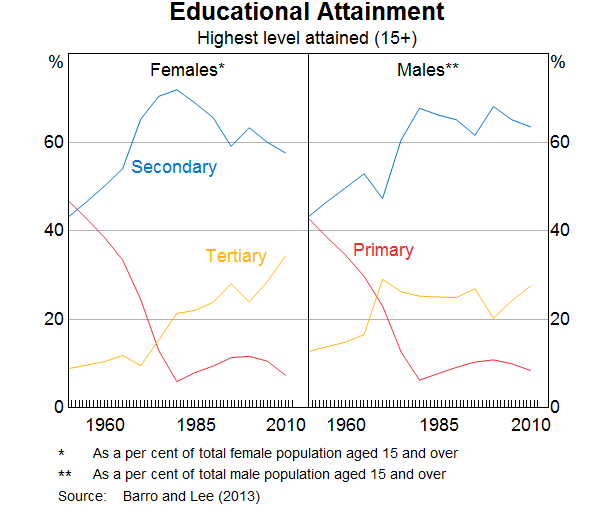
The increasing educational attainment of females, however, did not translate into a significant increase in women's participation in the workforce until the 1960s.
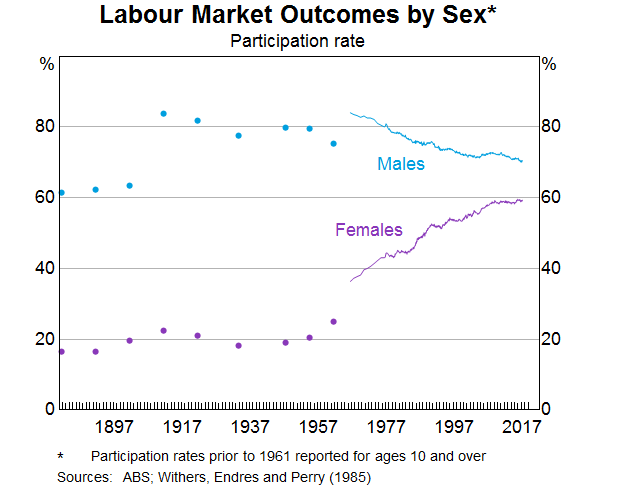
One factor that encouraged the increase in participation was that technological progress after World War II made a whole range of household appliances available, which meant that less time was required to manage a household. Institutionalised discrimination around how women were allowed to participate in the workforce was an important factor that had discouraged their participation.
When the NSW Public Service first opened itself to female employees in 1900, females and males were employed on the same terms. This was the experience of Edith Swain, who was one of the first women to join the NSW public service and was also the first female graduate of economics from Sydney University (Radi 2002). Edith studied part time to gain a BA in 1909 and a BEc in 1914. That same year, she also became a professional officer in the Department of Industry. While Edith was busy working and studying, the industrial courts established the principle that males needed to be paid a basic wage that could support a family. In 1915 the NSW public service introduced lower pay scales for women and restricted the jobs they could be employed to do. Edith's biography records that around this time her career stalled and she eventually transferred from being a professional officer to clerical duties. In doing so, she also accepted a fall in her salary. Although NSW became the first jurisdiction to legislate for equal pay in 1958, federal legislation on equal pay wasn't introduced until 1969.
It is often the case that workplace laws reflect the attitudes of society, but they also serve to reinforce and entrench those attitudes. Well into the 1960s, women were generally expected to resign from their jobs when they got married. This meant that, for many women, the financial benefits of going to university were unlikely to cover the costs of going in the first place. And yet women still enrolled.
Two examples are Winifred Lipsomb, another early student of economics at Sydney University who graduated in 1916, and Edna Pritchard, who was among the first graduates of architecture at Sydney University in the 1920s, and happens to be my grandmother.
Both women undertook tertiary education, but married soon after they had completed their studies and so never earnt a living from their education. At first glance, this looks like a wasted investment. But if you look at what their children did, a broader view on how to measure the payoffs to education becomes apparent. Edna's daughter, my Aunt Evelyn, went to university and spent her career either teaching at, or running, girls' schools. In doing so, she had a significant influence over the opportunities available to the next generation of women. Winifred's daughter, Dorothy, became a pilot and a doctor and was awarded an Order of Australia for her commitment to rural medicine and her role as a pioneer of female aviation. The lesson to take away from these examples, and a vast academic literature, is that you cannot overestimate the value of having well-educated mothers. They help to change society's expectations about the role of women by changing the opportunities they provide their children.
Moving ahead to the 1970s, the number of women and men completing tertiary education picked up sharply. It is not a coincidence that tertiary education effectively became free at this time. Since then, the upward trend for women has been stronger, and they are now more likely to complete tertiary education than men.
Since the mid 1980s, most of the increase in employment has come from non-routine cognitive jobs. This includes occupations such as doctors and lawyers. Women have been an important part of this trend. Women have also benefitted from the trend increase in demand for non-routine manual jobs, such as carers and hospitality workers. Some of this growth has come about because the increasing participation of women in the work force has meant that some of the roles they did unpaid in the home have moved to the paid workplace. In contrast to these two categories of non-routine jobs, the growth in routine jobs has been relatively limited partly because technological change has allowed many of these jobs to be automated or even be moved to other countries where labour costs are lower (Heath 2016).
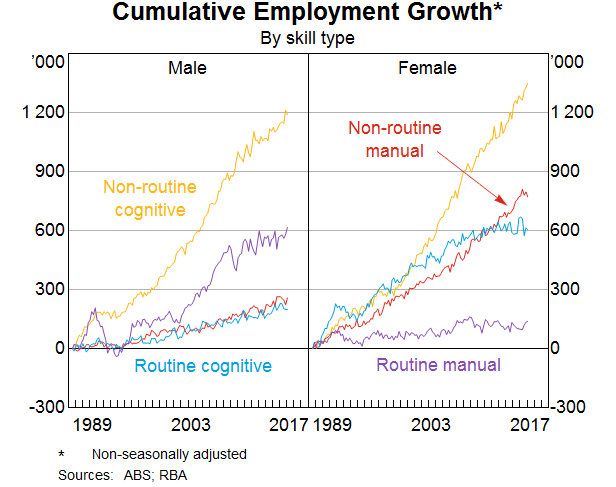
On these metrics, Louisa Macdonald would conclude women have made considerable progress towards economic and social equality. Indeed, a number of occupations that require tertiary study, such as accounting, law, the natural sciences and medicine, have become more gender balanced.
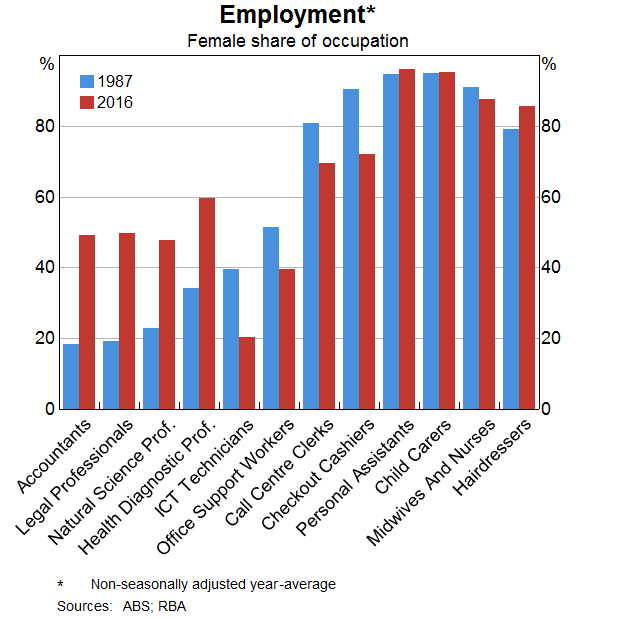
Other occupations that looked reasonably balanced in 1987, such as IT support technicians, have become more male dominated. At the other end of the spectrum, many occupations that were very female dominated in 1987, such as personal assistants, childcare workers and nurses, have remained female dominated. In some cases, such as hairdressing, female-dominated occupations have become more so.
In addition to persistent gender segregation in some occupations, another concern is that occupations that are dominated by women tend to have relatively low wage levels. In addition, women working within any given occupation are generally paid less than men.
This graph does not control for a whole range of factors, such as differences in experience or education, but analysis that does do this comes up with the same basic finding (see for example the Workplace Gender Equality Agency (WGEA) website or Goldin (2015)). Gender pay gaps continue to exist almost half a century after the equal pay reforms undid the institutionalised pay discrimination against women that was put in place more than a century ago.
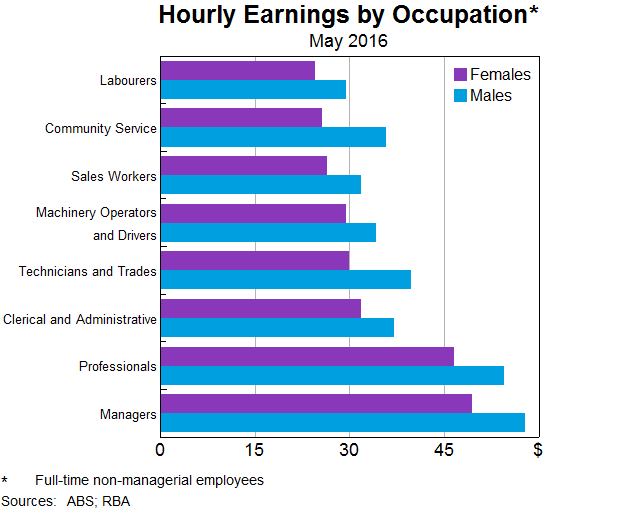
Why is it that some occupations are becoming more segregated by gender, while others are moving closer to a 50:50 representation? As an economist working in a male-dominated occupation, this question is an important one and brings me to the second, and more personal, perspective I have on gender equality.
One issue that many male-dominated professions face is what is known as a 'pipeline problem'. This is another way of saying that the pool we are recruiting from has a significant gender imbalance.
This imbalance is already clear by the time students finish high school. In NSW, there were roughly four girls to every five boys studying a STEM subject in Year 12 in 2016. For economics, there is only one girl to every two boys. This is particularly troubling when you go back to the 1990s and see that the proportion of girls studying STEM subjects and economics was roughly 50 per cent.
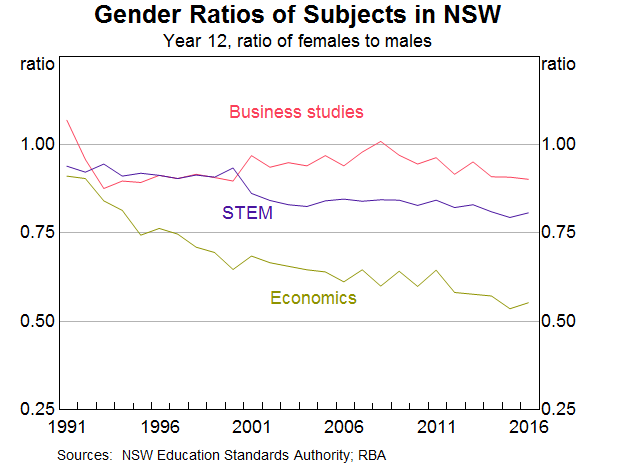
It is hard to know why this has happened. There is no evidence that there is a difference in aptitude between girls and boys. It may be that girls are making subject choices based on incorrect perceptions of what opportunities different subject choices create, or indeed limit. Whatever the reason, some sectors of the economy are not seeing their fair share of the talent as a result and are not benefitting from the diversity of thought and approach that having more women would bring.
There are a number of ways to tackle these issues. Some involve improving the way these subjects are taught and trying to change perceptions about 'boy' subjects and 'girl' subjects. To this end, the RBA supports the efforts of the Australian Mathematical Sciences Institute, which works with schools to improve the supply of mathematically well-prepared students entering tertiary education. The RBA has created an annual scholarship to provide an economics teacher with an opportunity to find ways to improve the teaching of economics, particularly to girls. We have also set up a team to find ways of using our expertise to support economics educators.
Another way to tackle these issues is to improve information about what career options are available at the end of any given course of study. The RBA tries to use events like this as an opportunity to raise awareness about the fulfilling careers that are available in public policy at institutions like the RBA for bright women (and men) who want to use their problem-solving and communication skills for the public good.
Clearly, professions like economics aren't going to have a balanced gender representation if they don't start with a balanced inflow of recruits. But study after study has also shown that the representation of women in the senior ranks of business and government is less equal than it was at recruitment. Working on the pipeline is not enough to guarantee that gender representation will progressively improve over time because the pipeline leaks.
One point that is often made in this discussion is that a traditional career path in many occupations makes it difficult to combine career progression with spending time on other aspects of their life, such as caring responsibilities or being more involved with community activities. This lack of flexibility is generally more apparent in traditionally male-dominated occupations. Although this discussion is often motivated by the need to have more flexibility to retain talented women, there has also been a growing awareness that many men would also like that flexibility. After all, gender equality cuts both ways.
At the same time, businesses and government have increasingly recognised that wanting to make more time for non-work activities does not necessarily make someone less ambitious about what they want to achieve over the longer term in their work life, or that they have reached their full potential. However, even when a degree of flexibility is available, there is a growing body of evidence that shows taking advantage of this option can be associated with a pay penalty (see for example the WGEA website and Goldin (2014)). Once again, progress is being made, but there is clearly more work to be done.
Another dimension of the leaky pipeline problem is that decisions about promotions and work opportunities are likely to be affected by the unconscious biases we all carry with us. We all tend to feel more comfortable around people we relate to easily. We all have preconceived ideas about what someone in a leadership role should look like. Unless these unconscious biases are challenged, the people who are most likely to make progress in their careers are those that are similar to the existing decision makers. This exposes our institutions to a range of risks, such as group think, that can be mitigated by having more diversity throughout the organisation.
Challenging these biases requires an awareness that they exist in the first instance. Even doing something as simple as looking at the language that is used to describe a Heidi vs a Howard based on an otherwise-identical CV can reveal these underlying biases. There also needs to be a willingness to be more objective about what merit looks like and to examine whether processes around recruitment and promotion unintentionally create biased outcomes.
Another third possible explanation for why women are not well represented in senior management is that women limit their own opportunities by choosing not to challenge the status quo. This is a much more controversial position because it could be taken to imply that the onus is on women to 'fix themselves' rather than on institutional culture to adapt. But then the question we are left with is: how can we ever expect cultural change if we don't challenge the status quo?
There is no question that actively challenging the status quo is hard work. In most cases, women who have done this successfully have had strong support networks, in the form of a supportive family or a supportive partner (especially if balancing work and family responsibilities are a consideration). Support from work colleagues, particularly senior men, is often another factor.
However, it is important to recognise that not everyone is in a position to actively challenge the status quo. Some of my earlier examples showed how many women challenge the status quo by providing the next generation with support and opportunities.
Not many of us can claim to have done as much to change the opportunities available to the next generation of women as Louisa Macdonald, but I think we all have a responsibility to do what we can to make society a more equal place. Not only because it's the right thing to do, but because we leave talent on the table if we don't.
So, bringing this all together, what would Louisa Macdonald think about the current status of women in society? I think she would celebrate the progress women have made towards becoming equal social and economic agents, but I think she would also conclude that much more still needs to be done.
References
Heath A (2016), ‘The Changing Nature of the Australian Workforce’, Speech at the CEDA ‘Future Skills: The Education and Training Pipeline’, Brisbane, 21 September.
Goldin C (2014), ‘A Grand Gender Convergence: Its Last Chapter’, American Economic Review 104(4), pp 1091–1119.
Goldin C (2015), ‘How to Achieve Gender Equality’, The Milken Institute Review, Third Quarter, pp 24–33.
Radi H (2002), ‘Swain, Edith Muriel Maitland (1880–1964)’, Australian Dictionary of Biography, National Centre of Biography, Australian National University.
Withers G, T Endres and L Perry (1985), ‘Australian Historical Statistics: Labour Statistics’, ANU Source Papers in Economic History No 7.